Even in times of war-like situations, trotting the globe, the world has sustained its happiness quotient and benevolence bump since Covid-19, as per the World Happiness Report, 2025. The United Nations Sustainable Development Solutions Network (UNSDSN) has published this report, wherein India has fared better in the happiness index 2025, improving its ranking to 118th from the 126th rank recorded in 2024. The Voices student reporter presents the happiness stats and analysis of India’s position in the index.
Background:
Bhutan, the country that has prioritised Gross National Happiness (GNH) over GDP since the 1970s, inspired the creation of the World Happiness Report. In 2011, Jayme Illien, an activist, philanthropist, economist, and philosopher, proposed the idea of International Happiness Day at the UN General Assembly, and the resolution was passed in the same year. Jayme Illien is also the founder of Happytalism, and Luis Gallardo is the president of the World Happiness Foundation. In 2012, the UN General Assembly designated 20th March as ‘World Happiness Day’. First started in 2013, the objective behind this day is to inform people about the importance of happiness in their lives and the need to incorporate happiness into public policies. The Theme for World Happiness Day 2025 was Caring and Sharing.

This World Happiness Day, the Well-being Research Centre at University of Oxford in partnership with Gallup (the UN Sustainable Development Solutions Network -UNSDSN) published The World Happiness Report 2025. Here are some excerpts from the report and its inferences:
The report focuses on the impact of caring and sharing on people’s happiness. It has been observed that the Benevolence Bump has been sustained since COVID-19. Caring is being blessed twice; it blesses those who give and those who receive.
This report highlights both of these effects: the benefits to the recipients of caring behaviour and the benefits to those who care for others. Both helpers and recipients experience greater happiness from caring and sharing in the context of the three Cs: caring connections, choice, and clear positive impact.
Key Highlights
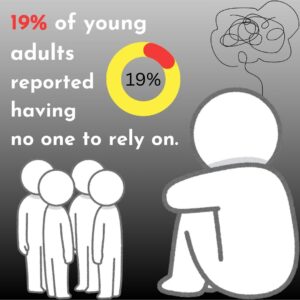 Happiness rankings remain stable this year, with Nordic countries (including Finland at top for 8th consecutive year) maintaining top positions.
Happiness rankings remain stable this year, with Nordic countries (including Finland at top for 8th consecutive year) maintaining top positions.- Countries in Latin America, such as Costa Rica and Mexico, jumped into the top 10 for the first time.
- Both the UK and the US graphs have decreased to 23rd and 24th, respectively. The US is in its lowest-ever position.
- In general, the western industrial countries are less happier than they were between 2005 and 2010.
- 19% of young adults have no one to rely on
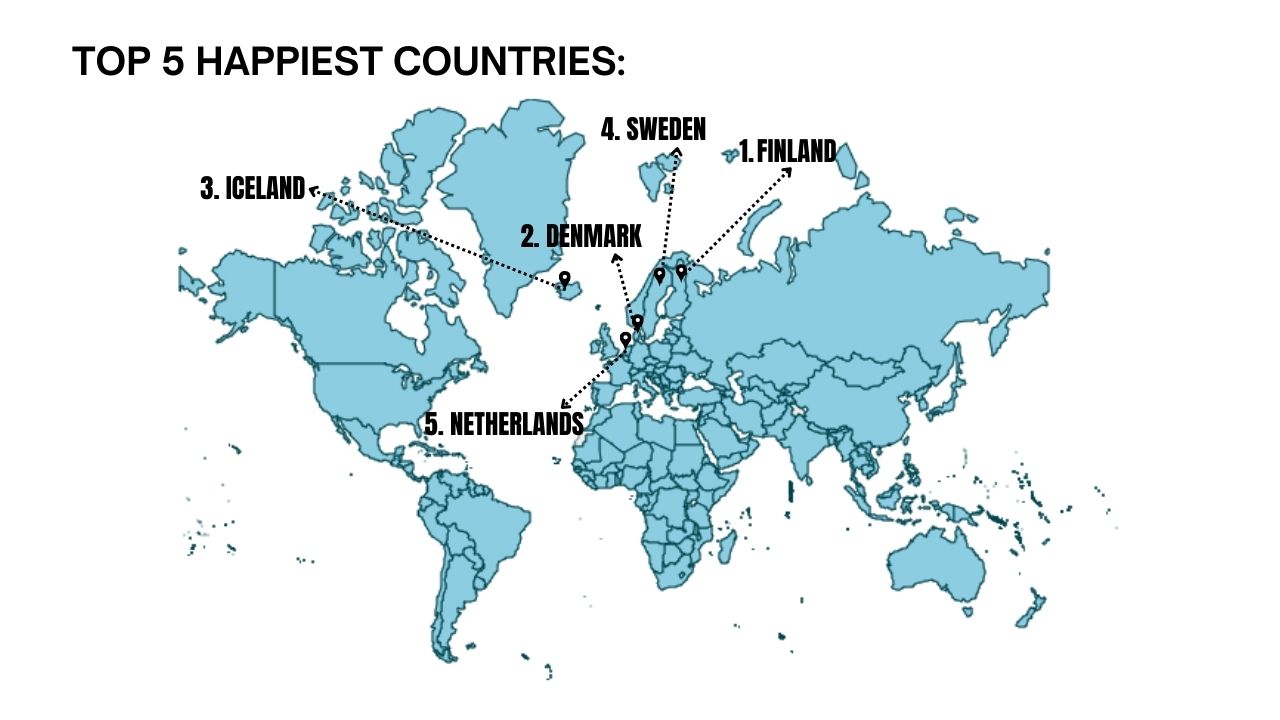
TOP 5 HAPPIEST COUNTRIES
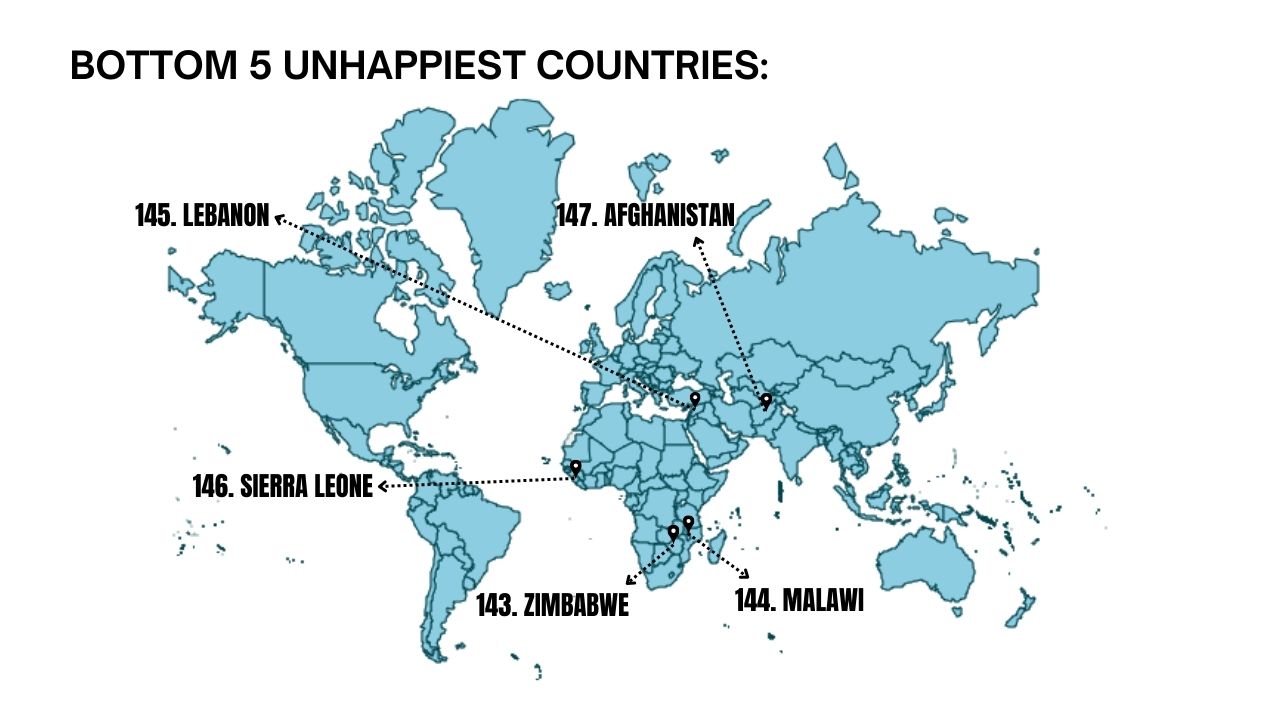
BOTTOM 5 COUNTRIES
India’s Ranking and Performance
India’s ranking: 118th (2025)
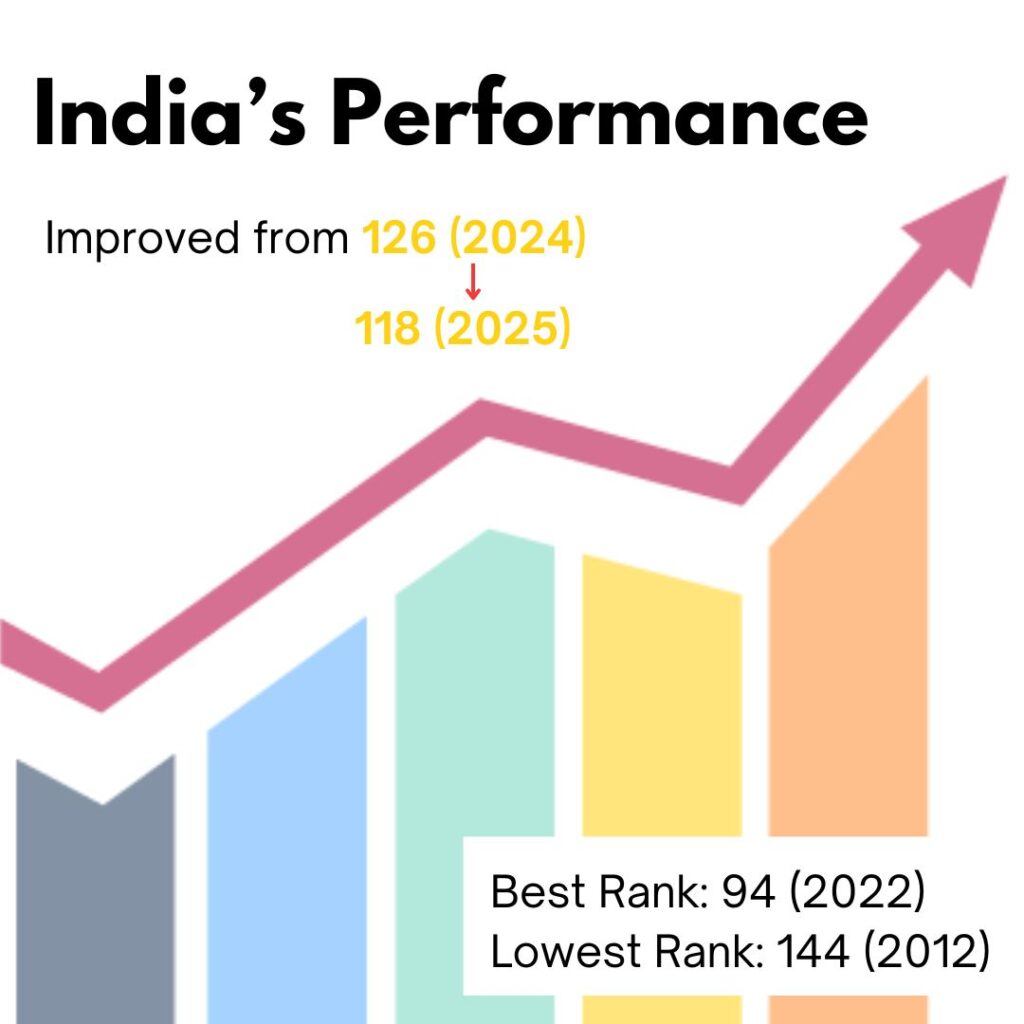
Neighboring Countries Ranking: China (68th), Nepal (92nd), Pakistan (109th), Myanmar (126th), Sri Lanka (133th), Bangladesh (134th) and Afghanistan (147th)
India’s ranking improved from 126th in 2024 to 118th in 2025. India’s lowest rank in the Happiness Index was 144th in 2012, and its highest was 94th in 2022. There’s been a steady increase in India’s ranking in the happiness index. The three major factors contributing to steady growth in India’s happiness index included growth in GDP per capita, more personal freedom, and a decrease in corruption perception.
Despite scoring better in GDP per capita, India still lags behind Pakistan in the Happiness index. Higher economic inequality is one of the major reasons for India’s low ranking in the happiness index compared to other countries. Other reasons include lack of social support, air pollution, congested living, lack of healthcare, stress in daily life, etc.
How the countries were ranked?
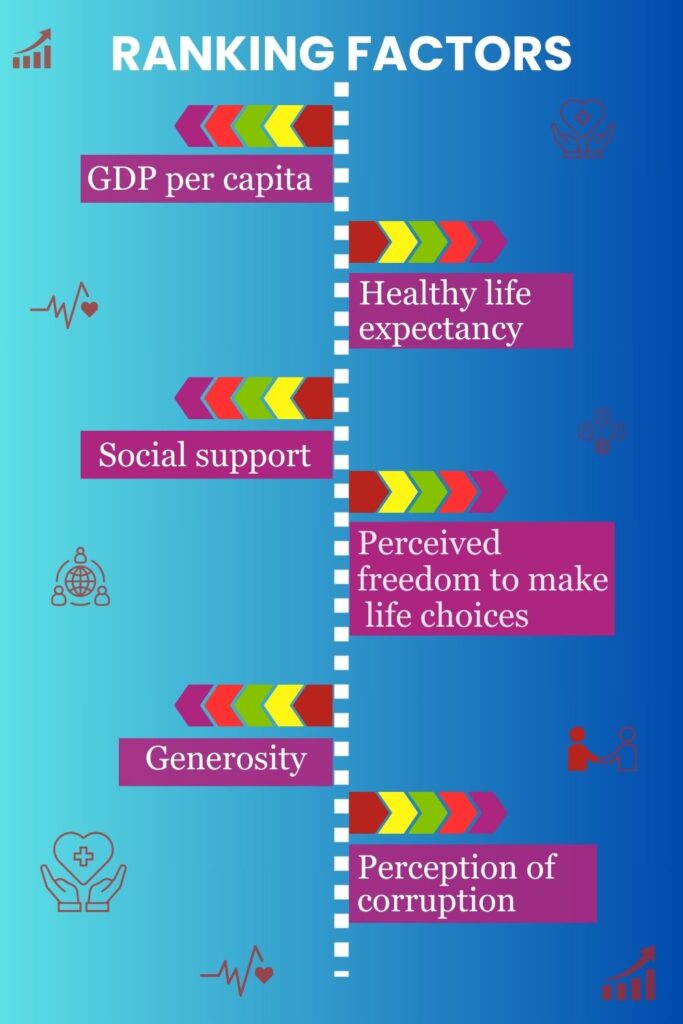
- The rankings are based on a 3-year average of people’s life evaluations, in which respondents rated their current life on a scale from 0 to 10.
- The happiness score was determined by six key factors: GDP per capita, social support, healthy life expectancy, perceived freedom to make life choices, generosity, and perceptions of corruption.
- Determinants of happiness included caring and sharing, sharing meals, living with family and other relatives, and social connections. Prosocial behaviors included donating, volunteering, helping others, and trusting and giving money or other essential things to other people.

This report covered three kinds of benevolent acts through which kindness is seen in people across the world, including donating, volunteering and helping others through any means. Under this report, subjective well-being was measured on the basis of three leading well-being indicators: life evaluations, positive emotions, and negative emotions.
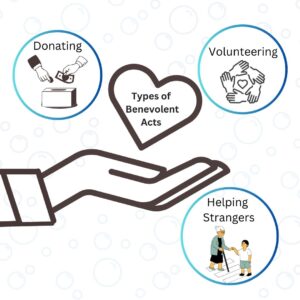

This report mentions different kinds of households based on which happiness was gauged. It found that households that included couples with at least one kid and other relatives are happier than those of single-parent households or couples without kids.
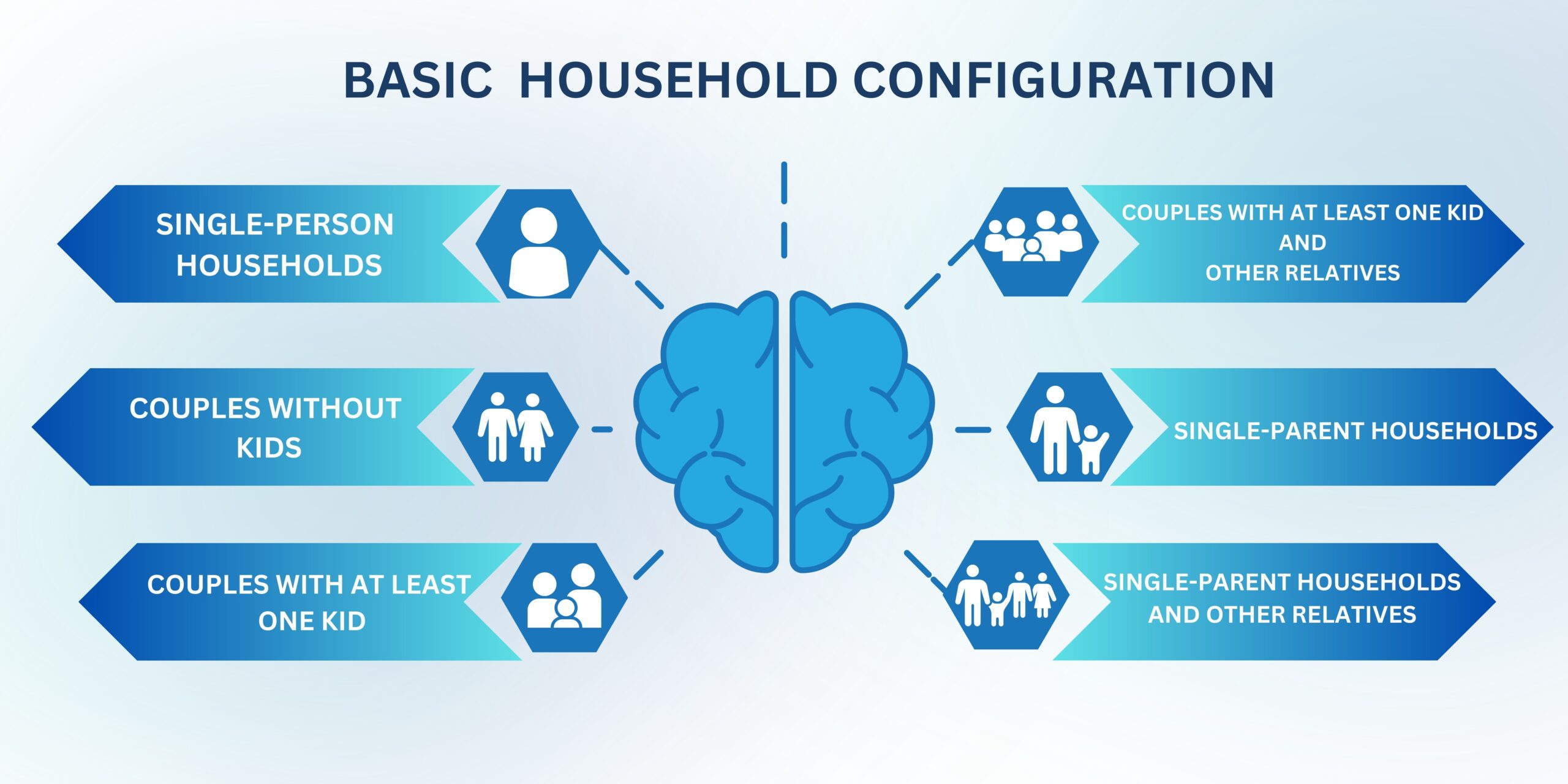
Analysis
In 2024, benevolent acts continue to grow among all generations and almost all global regions, despite evidence of a return towards pre-COVID levels. There are stark differences in rates of meal sharing around the world. In the United States, using data from the American Time Use Survey, the reports find clear evidence that Americans spend more and more time dining alone. In 2023, roughly 1 in 4 Americans reported eating all their meals alone the previous day – an increase of 53% since 2003.
Couples who live with at least one child, or couples who live with children and members of their extended family, have especially high average life satisfaction. 19% of young adults worldwide have no one to rely on. Increasing prosocial behaviour is connected to decreasing deaths of despair around the world. Deaths of despair are nearly four times higher among men than women and more than double among those aged 60+ compared with those aged 15–29.
In Europe and the United States, the decline in happiness and social trust explains a large share of the rise in political polarisation and votes against ‘the system’. The report estimates how much happiness per dollar is created by specific forms of charitable expenditure. Happiness is measured in well-being-years (WELLBYs).
Based on the Determinants of Happiness as pointed out in the report:
- Caring and Sharing: 10% more than 2017-19
- Sharing meals: Increase of 53% since 2003.
- Living with others: Household size of four to five predicts the highest happiness levels.
- Social connections: 39% increase compared to 2006.
- Pro social behaviour:10% increase
- Trusting and giving to others: Decline
Countries with strong social trust, community engagement registered higher happiness levels
As per the report, it is observed that countries with strong social trust and community engagement have higher happiness levels. Countries that scored highest in all the ranking factors are the happiest countries. On average, countries that have provided more untied official development assistance (ODA) are happier. Countries that have high refugee population shares are less happy. The decline in happiness and social trust in the US and parts of Europe is the rise and direction of political polarisation. The report mentions that the reason behind the hike in Latin American countries, i.e. Mexico and Costa Rica, is that four or five people are living together, enjoying the highest levels of happiness.
Infographics: Khushi Choudhury
Copyeditor: Arunima Maharshi

